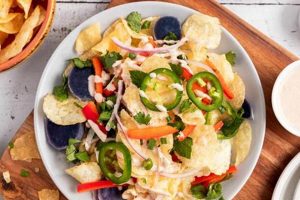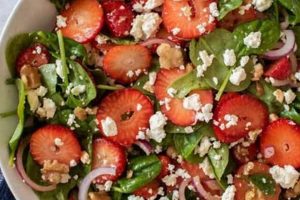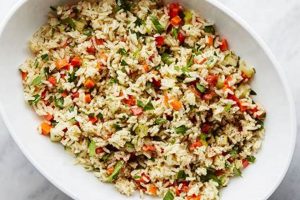Dishes categorized as chilled grain salads featuring rice as the primary ingredient encompass a wide range of flavors and textures. These versatile preparations often incorporate cooked, cooled rice combined with various vegetables, proteins, herbs, and dressings. A classic example includes a vinaigrette-dressed mixture of long-grain rice, chopped cucumbers, tomatoes, bell peppers, and red onion, perhaps with the addition of chickpeas or feta cheese.
Such dishes offer a refreshing and convenient meal option, particularly suitable for warm weather or as part of a buffet or potluck. Their adaptability allows for customization based on dietary needs and preferences, incorporating a wide range of ingredients from different culinary traditions. From simple, vinegar-based dressings to more complex flavor profiles featuring Asian-inspired sauces or Mediterranean herbs, these salads provide a balanced and flavorful meal that can be prepared in advance. Historically, the concept of utilizing leftover cooked grains in salads likely arose as a practical way to minimize food waste and create a satisfying meal from readily available ingredients.
The following sections will explore variations on this culinary theme, including specific ingredient combinations, preparation techniques, and serving suggestions for different occasions.
Tips for Crafting Exceptional Rice Salads
Creating a successful cold rice salad involves attention to detail and an understanding of how different elements contribute to the final dish. The following tips offer guidance for achieving optimal flavor, texture, and overall appeal.
Tip 1: Rice Selection and Preparation: Opt for long-grain rice varieties like basmati or jasmine, as they remain separate and fluffy when cooked. Rinsing the rice before cooking removes excess starch, contributing to a less sticky texture. Cooling the rice completely before adding other ingredients prevents the salad from becoming mushy.
Tip 2: Vegetable Incorporation: A variety of textures and colors enhances the salad’s appeal. Consider crisp vegetables such as cucumbers, bell peppers, and carrots. Blanching or roasting certain vegetables before adding them can intensify their flavor and improve their texture.
Tip 3: Protein Enhancement: Adding protein elevates the salad to a complete meal. Grilled chicken or fish, cooked shrimp, chickpeas, or lentils are excellent choices. Ensure protein elements are cooled before combining them with the rice.
Tip 4: Flavorful Dressings: The dressing is crucial for binding the ingredients and imparting flavor. Vinaigrettes, creamy dressings, or those with Asian-inspired flavors offer diverse options. Consider the other ingredients when selecting a dressing to achieve a balanced and harmonious flavor profile.
Tip 5: Herb and Spice Integration: Fresh herbs such as parsley, cilantro, or mint add brightness and complexity. Dried spices, like cumin or paprika, can also enhance the flavor profile. Add herbs just before serving to maximize their freshness and aroma.
Tip 6: Proper Storage: Store the salad in an airtight container in the refrigerator. Consume it within two to three days for optimal quality and food safety.
Tip 7: Serving Suggestions: Cold rice salad can be served as a light lunch, a side dish, or a component of a buffet. Garnish with toasted nuts, seeds, or a sprinkle of cheese for added texture and visual appeal.
By following these guidelines, one can create a flavorful, visually appealing, and satisfying cold rice salad that is perfect for various occasions.
The following section provides a selection of specific recipes that illustrate these principles in practice.
1. Rice Variety
Rice variety significantly influences the texture and overall success of a cold rice salad. Different rice types possess unique characteristics that affect their behavior when cooked and cooled. Long-grain varieties, such as basmati and jasmine, tend to remain separate and fluffy, preventing the salad from becoming overly sticky or mushy. Their delicate flavor profiles also allow other ingredients to shine. Medium-grain rice, while more absorbent and potentially stickier, can work well in salads with robust dressings and ingredients that provide textural contrast. Short-grain rice, commonly used for sushi, is generally less suitable for cold salads due to its sticky consistency. Choosing the appropriate rice variety establishes a foundation for a well-balanced and enjoyable cold rice salad.
The impact of rice variety is evident when comparing a salad made with long-grain basmati rice to one made with short-grain glutinous rice. The basmati rice salad will maintain a light and airy texture, with individual grains distinct and coated in dressing. Conversely, the glutinous rice salad is likely to become dense and compact, with the rice clumping together. This difference in texture affects not only the eating experience but also the ability of the rice to absorb flavors from the other ingredients and the dressing. Therefore, understanding the properties of different rice varieties empowers one to make informed choices that contribute to the desired outcome.
Selecting the correct rice variety is a fundamental step in creating a successful cold rice salad. While personal preference plays a role, the desired texture and compatibility with other ingredients should guide the decision-making process. Opting for long-grain varieties generally yields the most desirable results for cold salads, providing a light, fluffy base that complements a wide range of flavors and textures. Careful consideration of rice variety, alongside other key components, ensures a cohesive and enjoyable culinary experience.
2. Ingredient Combinations
Ingredient combinations are fundamental to the versatility and appeal of cold rice salads. The interplay of flavors, textures, and colors determines the overall sensory experience. A well-composed salad balances contrasting elements, creating a harmonious and satisfying dish. Understanding the relationships between different ingredients allows for informed choices that enhance the final product.
- Vegetables:
Vegetables provide texture, color, and nutritional value to cold rice salads. Crisp vegetables like cucumbers, bell peppers, and carrots offer a refreshing contrast to the soft rice. Roasted or grilled vegetables, such as zucchini, eggplant, or corn, add depth of flavor. Blanching certain vegetables, like green beans or broccoli, preserves their vibrant color and crisp-tender texture. The choice of vegetables influences not only the salad’s flavor profile but also its visual appeal.
- Proteins:
Protein additions transform a cold rice salad into a substantial meal. Grilled chicken or fish, cooked shrimp, or shredded rotisserie chicken offer lean protein options. Legumes, such as chickpeas, black beans, or lentils, provide plant-based protein and fiber. The protein component should complement the other ingredients and contribute to a balanced nutritional profile.
- Fruits and Dried Fruits:
Incorporating fruits or dried fruits introduces sweetness and textural complexity. Fresh fruits like grapes, berries, or chopped apples offer a juicy burst of flavor. Dried fruits, such as cranberries, raisins, or apricots, provide a chewy texture and concentrated sweetness. The choice of fruit should harmonize with the other ingredients and the overall flavor profile of the salad.
- Herbs, Spices, and Other Flavor Enhancers:
Fresh herbs, spices, and other flavor enhancers contribute depth and complexity to cold rice salads. Freshly chopped herbs like parsley, cilantro, mint, or dill add brightness and aroma. Spices such as cumin, paprika, or chili flakes introduce warmth and subtle heat. Other additions, like toasted nuts, seeds, or crumbled cheese, provide textural contrast and enhance the flavor profile. These elements play a crucial role in elevating the salad beyond a simple combination of ingredients.
The careful selection and combination of these ingredient categories are crucial for creating a successful cold rice salad. A thoughtful approach to balancing flavors, textures, and colors results in a dish that is not only visually appealing but also nutritionally balanced and deeply satisfying. By understanding the role of each ingredient and how it interacts with others, one can craft a cold rice salad that is tailored to individual preferences and dietary needs. The possibilities are virtually limitless, allowing for endless variations on this versatile and adaptable dish.
3. Dressing Selection
Dressing selection significantly impacts the overall flavor profile and enjoyment of cold rice salads. The dressing acts as a unifying element, binding the diverse ingredients and imparting a cohesive flavor. The choice of dressing should complement the other components, enhancing their individual characteristics without overpowering them. A light and tangy vinaigrette, for example, might pair well with a Mediterranean-inspired salad featuring olives, feta cheese, and fresh herbs. Conversely, a creamy dressing based on mayonnaise or yogurt might complement a salad with roasted vegetables and shredded chicken. The interplay between the dressing and the other ingredients is crucial for achieving a balanced and harmonious flavor profile. An overly acidic dressing can mask the subtle flavors of fresh vegetables, while a heavy dressing can weigh down a salad meant to be light and refreshing. Careful consideration of the dressing’s intensity, acidity, and overall flavor profile ensures a successful outcome.
Practical application of this understanding involves considering the specific ingredients in the salad and choosing a dressing that enhances their flavors. A salad with delicate ingredients like shrimp and fresh herbs benefits from a light vinaigrette that won’t overpower their subtle flavors. A more robust salad with roasted vegetables and grilled chicken can handle a richer, more assertive dressing. The dressing’s texture also plays a role. A creamy dressing adds richness and coats the ingredients, while a vinaigrette provides a lighter, more refreshing touch. Experimentation with different dressings allows for the discovery of flavor combinations that best suit individual preferences. For instance, a sesame-ginger dressing complements Asian-inspired salads, while a lemon-herb vinaigrette enhances Mediterranean flavors.
In summary, dressing selection is a crucial element in crafting successful cold rice salads. The dressing serves not only to bind the ingredients but also to impart a cohesive flavor profile. Understanding the interplay between the dressing and other components, considering factors like acidity, intensity, and texture, allows for informed choices that elevate the overall dining experience. Through careful consideration and experimentation, individuals can discover a range of dressings that complement their preferred flavor combinations and enhance the enjoyment of this versatile dish.
4. Freshness and Quality
Freshness and quality of ingredients directly correlate with the overall success of cold rice salad recipes. These salads, often featuring a variety of components, rely on the integrity of each element to contribute to the final dish’s flavor, texture, and safety. Compromised freshness can lead to undesirable outcomes, ranging from off-flavors and mushy textures to potential foodborne illnesses. Using high-quality, fresh ingredients ensures a vibrant, flavorful, and safe culinary experience.
Consider the impact of ingredient freshness on a classic cold rice salad with vegetables. Freshly diced cucumbers and bell peppers provide a crisp, refreshing counterpoint to the tender rice. However, if these vegetables are wilted or nearing spoilage, they introduce unpleasant flavors and textures, detracting from the overall enjoyment. Similarly, the use of freshly cooked and properly cooled rice is essential for food safety and optimal texture. Day-old rice, while convenient, can harbor bacteria if not handled and stored correctly. Furthermore, the quality of the dressing components, such as oils, vinegars, and herbs, contributes to the salad’s overall flavor profile. Rancid oils or wilted herbs can negatively impact the taste, diminishing the intended culinary experience. A practical example demonstrating this principle is the stark contrast between a salad made with vibrant, freshly chopped herbs and one made with dried or wilted herbs. The former offers a bright, aromatic dimension, while the latter falls flat, lacking the vibrancy that fresh herbs provide.
Prioritizing ingredient freshness and quality is paramount in crafting exceptional cold rice salads. The impact extends beyond flavor and texture, encompassing food safety considerations. Understanding this connection empowers informed ingredient selection, appropriate storage practices, and ultimately, a more enjoyable and safe culinary experience. The choice to prioritize fresh, high-quality ingredients demonstrates a commitment to culinary excellence and a respect for the ingredients themselves.
5. Serving and Storage
Serving and storage practices significantly influence the quality, safety, and overall enjoyment of cold rice salads. These salads, often incorporating a variety of ingredients, require careful handling to maintain their freshness and prevent bacterial growth. Proper serving techniques enhance the sensory experience, while appropriate storage preserves the salad’s integrity and extends its shelf life. The interplay between these practices is crucial for maximizing the culinary potential of cold rice salads.
Serving cold rice salads at the appropriate temperature is essential for maximizing their flavor and texture. Chilling the salad thoroughly allows the flavors to meld and enhances the refreshing qualities of the dish. Presentation also plays a role in the overall dining experience. Serving the salad in an attractive bowl or platter, garnished with fresh herbs or a sprinkle of nuts, elevates its visual appeal. Furthermore, providing appropriate serving utensils ensures hygienic handling and prevents cross-contamination. For instance, a summer picnic featuring a cold rice salad benefits from pre-chilling the salad and transporting it in a cooler with ice packs. Serving the salad in individual containers or with serving spoons minimizes handling and maintains food safety.
Proper storage is paramount for maintaining the quality and safety of cold rice salads. Storing the salad in airtight containers in the refrigerator prevents exposure to air and minimizes the risk of bacterial growth. Prompt refrigeration after preparation is crucial, especially for salads containing perishable ingredients like meat, seafood, or dairy products. Adhering to recommended storage times ensures optimal quality and minimizes the risk of foodborne illness. For example, a leftover rice salad should be refrigerated within two hours of preparation and consumed within two to three days. Failing to adhere to these guidelines can compromise the salad’s quality and potentially lead to health risks. Understanding and implementing proper serving and storage practices is essential for maximizing the enjoyment and safety of cold rice salads.
Frequently Asked Questions
This section addresses common inquiries regarding cold rice salad preparation, offering practical guidance for achieving optimal results.
Question 1: What type of rice is best suited for cold rice salads?
Long-grain rice varieties, such as basmati or jasmine, are generally preferred for their ability to remain separate and fluffy when cooled. These varieties contribute to a desirable texture and prevent the salad from becoming overly sticky.
Question 2: How can stickiness be prevented in cold rice salads?
Rinsing the rice thoroughly before cooking removes excess starch, which contributes to stickiness. Cooling the rice completely before combining it with other ingredients also helps maintain a desirable texture. Using the correct rice-to-water ratio during cooking further minimizes stickiness.
Question 3: What are suitable protein additions for cold rice salads?
Versatile protein options include cooked chicken, fish, shrimp, chickpeas, lentils, or tofu. The chosen protein should complement the other ingredients and contribute to a balanced nutritional profile.
Question 4: How long can cold rice salad be stored safely?
Properly stored in an airtight container in the refrigerator, cold rice salad typically remains safe to consume for two to three days. Discard any salad that exhibits signs of spoilage, such as off-odors or mold growth.
Question 5: Can frozen vegetables be used in cold rice salads?
While fresh vegetables are generally preferred, frozen vegetables can be used in cold rice salads. Thaw and drain them thoroughly before incorporating them into the salad to prevent excess moisture. Choose frozen vegetables that maintain their texture well after thawing.
Question 6: How can one adapt cold rice salad recipes for different dietary needs?
Cold rice salads are highly adaptable. Gluten-free versions can be achieved by using gluten-free grains or omitting grains altogether. Vegetarian and vegan options can be created by incorporating plant-based proteins and omitting animal products. Adjustments to the dressing ingredients can accommodate other dietary restrictions, such as low-sodium or low-fat diets.
Understanding these fundamental aspects of cold rice salad preparation allows for informed ingredient choices and techniques, resulting in flavorful, enjoyable, and safe culinary creations.
For further culinary exploration, the subsequent section offers a collection of diverse cold rice salad recipes, showcasing various flavor profiles and ingredient combinations.
Conclusion
Cold rice salad recipes offer a versatile and adaptable culinary canvas. Exploration of key elements, including rice variety, ingredient combinations, dressing selection, freshness, and proper storage, reveals the potential for diverse flavor profiles and textures. Understanding the interplay of these components empowers informed decision-making, contributing to successful outcomes. From light and refreshing summer salads to hearty and flavorful main courses, the adaptability of cold rice salads allows for customization based on individual preferences and dietary needs.
The ongoing evolution of culinary traditions ensures that cold rice salad recipes will continue to adapt and innovate. Exploration of global cuisines and emerging culinary trends promises further expansion of flavor profiles and ingredient combinations. Embracing these possibilities allows for a continuous rediscovery of this versatile dish, solidifying its place as a staple in kitchens worldwide. The simplicity of preparation, combined with the potential for complex and satisfying flavors, ensures that cold rice salads will remain a valued culinary creation for generations to come.






